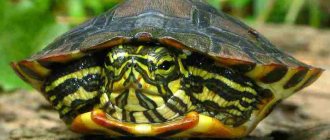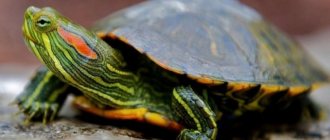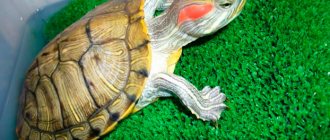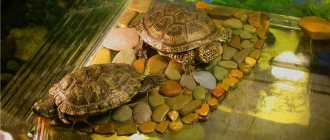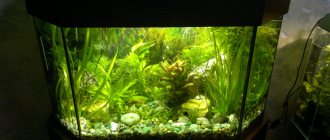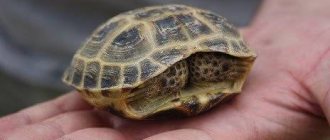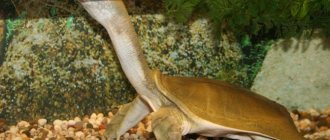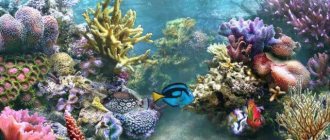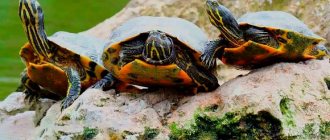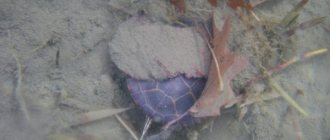When choosing a pet, you need to know how to properly care for it. He definitely needs to prepare suitable housing. In order not to make a mistake when choosing an aquarium for a red-eared slider, you should understand what its natural habitat is. If the right conditions are created, the animal will have good health and live a long time.
In order not to make a mistake when choosing an aquarium for a red-eared slider, you should understand what its natural habitat is.
Choosing an aquarium
When choosing an aquaterrarium for a red-eared turtle, it is necessary to take into account the size of the adult individual and the characteristics of its body. Reptiles spend a lot of time underwater, feeling safer there. The volume of the tank depends on the size of the turtles:
- individuals 3-10 cm long - up to 50 liters;
- 10-16 cm - up to 80 liters;
- 25 cm - up to 150 liters;
- adults - 120-170 liters.
It is advisable to start arranging an aquarium for a red-eared slider from the ground.
You should not use sand, glass stones and pebbles, as your pet can bite through all of this. It is better to give preference to larger shells - this will make your pet’s house more beautiful and saturate the liquid with calcium. You can also use a variety of mineral blocks.
In addition to water, reptiles also need dry land where they can bask and sunbathe. Such an area should occupy at least a quarter of the total area of the tank. The attachment of the island to the base of the aquarium must be strong. The aquaterrarium must be equipped with a lid that turtles cannot move. At the same time, such a lid must allow air to pass through so that pets can breathe.
Homemade terrarium for a red-eared turtle
You can make an aquarium for reptiles with your own hands. The assembly process does not require the use of complex devices and technologies.
Necessary materials
To make an aquarium you will need sheets of glass of the required size. You can cut parts in a workshop or at home. The cuts are made even, otherwise the seal of the container is broken. The thickness of the glass walls must be at least 6 mm.
During the assembly process you will need the following materials and devices:
glass cutter
sealant
ruler, square
adhesive tape
sandpaper
It is worth paying attention to preparing the workplace. A large table or free space on the floor will do. After assembly, the aquarium should not be touched for 3-5 days.
When working with glass, use protective gloves and a respirator.
Construction adhesive should not contain toxic components that penetrate into water.
Preference is given to silicone compounds.
Assembling the container
When making a terrarium for a red-eared turtle with your own hands, perform the following steps:
- Process the sections of glass sheets with sandpaper. When grinding, glass particles rise into the air, so you need to wear a mask when working.
- Place adhesive tape on the side wall so that the strip extends over the edge. The next part is placed on the sticky side of the tape. Both parts are installed at right angles with tape inward.
- Using adhesive tape, assemble all sides of the terrarium. The glass sheets are pressed tightly against each other. The sides are aligned parallel.
- Degrease the joints with alcohol and coat them twice with sealant. Each layer is leveled. To prevent glue from getting on the glass, areas adjacent to the joint are covered with masking tape. The sealant should completely fill the joints. Better connections are obtained when using a special gun.
- Install the bottom, securing it with drops of sealant. After checking the evenness, treat the joints with silicone.
- Leave the aquarium until the glue dries, then carefully turn it over. Remove the tape, erasing traces of glue. Treat all seams with a second layer of sealant and allow the composition to dry.
Checking the quality of work
After the joints have hardened, the container is filled with water and left for 2-3 days. If leaks are detected, the seams are treated with another layer of silicone.
A large-volume terrarium is reinforced with stiffening ribs. To do this, install horizontal plastic strips 4 cm wide in the corners. Glue is used for fastening.
Photos of homemade products
A homemade aquaterrarium for turtles is not much different from one bought in a store. You can see what these homemade products look like in the photo.
Arrangement of the island
The reptile spends a lot of time on the shore, so you can safely equip several areas of land. Each animal should have a separate island. One should be placed in the shade, and the other in a bright place. While on land, the reptile receives an ultraviolet tan. When arranging islands, it is important to listen to the following recommendations:
- The shore should rise smoothly from the bottom; steep cliffs are unacceptable. You can leave a ladder or a small ladder, use a large stone or a grotto with gentle walls.
- The surface of the sushi must be made rough, it must be made of high quality materials.
- For several turtles, you will need a large area so that they can be on land at the same time and fit freely there.
- If there are many islands, then some of them may be covered with water by several millimeters.
To prevent reptiles from escaping, you need to place dry land 30 cm below the edge of the aquarium.
The reptile spends a lot of time on the shore, so you can safely equip several areas of land.
Reptile Neighborhood
The red-eared turtle lives on land and loves to live in the water. She is very demanding of her environment. Therefore, choose aquariums that match the size of the animal, as well as those with access from the water to land.
Do not move new household members into terrariums with seasoned reptiles. The animal experiences stress from a change in environment and therefore becomes aggressive. Create a quarantine for 2 months. Newborn turtles should be treated with care and should have a separate place to live. Pets of the same size live next to each other without harming each other.
The proximity of red-eared turtles to aquarium fish in the same aquarium is not allowed. Reptiles can harm or eat fish. The maximum that can be done is to block a glass wall with small holes between them.
Temperature and lighting
The red-eared turtle feels comfortable in water whose temperature is between 23-28 °C. On a shaded island, it is necessary to maintain a temperature of 23-25 °C, and on a warm island - 28-32 °C. Such conditions are ideal for this reptile.
The main heating is provided by a special lamp, which is fixed above one of the land areas. When it is not possible to achieve the required temperature with one lamp, additional heating should be used, for example, a heater made in the form of a long glass tube. This heater is immersed in water. It is necessary to position it so that the pet cannot accidentally bite the electrical wire or touch it with its shell.
The health of a reptile is influenced by many factors, including the state of the water in the tank. To keep the liquid clean, it is better to install external filters. As for internal equipment, it is preferable not to use it. It quickly loses its effectiveness, becoming clogged with suspended matter.
The better the filter functions, the less often you will need to change the water. To maintain ecological balance, you need to change half the volume of liquid every week.
The incandescent lamp should be placed over one of the land areas. The light turns on only during the day. Be sure to take into account that red-eared turtles need UV lighting (UVB and UVA rays only). You should never use UVC, as such lighting can cause blindness in reptiles.
Without UV radiation, animals cannot produce vitamin D3 or absorb calcium, and this can cause rickets and even lead to death. The lamp must be on 12 hours a day. It is placed on top at a distance of 30 cm from the ground. The UV lamp is replaced once a year. This is the kind of aquarium needed for a red-eared slider. What the decor will be, everyone decides for themselves.
Which aquaterrarium is suitable?
The main criterion when choosing is safety. The beauty of the aquaterrarium should be secondary. Otherwise, you risk purchasing a toxic product that will poison your pet’s health.
The second criterion is suitable size. Based on how tall your turtle breed will grow. As a rule, the “height” of males is up to 17 cm, females – up to 20-21 cm. The reptile should feel free inside and move around without the feeling of limited space. As for the volume of the aquarium, this is at least 100, and preferably 150-200 liters for one individual, and 250 for two. If you take a smaller volume, the water will become polluted faster, and this is fraught with the development of diseases in turtles. The water level in the aquaterrarium should be at least 40 cm in order to change it less often.
If you take a young turtle, it is permissible to plant it in a small aquarium and then replace it with a larger one.
The aquaterrarium must have a lid, otherwise the turtle may decide to go on a journey. But the reptile will not last long without water, so provide a lid to prevent escape and possible death of the pet. If your aquaterrarium does not have a lid, then there should be at least 15-20 cm of reserve above the water level.
Decoration features
When decorating an aquarium, you should remember safety - this is the main principle of selecting decorations. You should not use objects in the decor that could injure your pet. Sharp corners and edges are unacceptable.
When decorating an aquarium, you should remember safety - this is the main principle of selecting decorations.
Do not use soil that is too fine, as animals may swallow it. Such soil becomes dirty faster, and cleaning it is not the easiest process. It is preferable to take pebbles in a fraction of 5-6 cm.
For small individuals, you can plant green plants. Adult turtles no longer need soil, and they can eat plants. As for fish, it is appropriate to introduce them only to young reptiles.
Plastic plants will also help you decorate your aquarium. They are attached to the ground using weights. You can also install artificial silk vines on dry land areas. Here's how to decorate your pet's house:
- pebbles;
- grottoes;
- driftwood.
As for the latter, it is not recommended to take too fresh driftwood, as they will release harmful substances. It is advisable to use pieces of wood that have been lying in a body of water for a long time.
Dimensions, material, shape
The aquarium must be made of glass, plexiglass or non-toxic food-grade plastic in two versions - closed or open. In the first case, there must be ventilation holes. The shape should be horizontal, that is, low and elongated. The volume of the container should range from 40 to 120 liters, depending on the size of the reptile.
The average aquaterrarium has dimensions of 70x40x40 (length, width, height). When choosing, you need to take into account that the length of the aquarium should be equal to the length of the shell x 7, and the width should be equal to Length / 2.
The material can be glass, organic glass, food-grade non-toxic plastic, cast acrylic. The side or back walls can, as an option, be decorated with decorative film.
Important Tips
When planning to set up an aquarium for a red-eared slider, it is important to know that not every tank is suitable for these purposes. You cannot keep reptiles in an aquarium whose volume is less than 50 liters. This house is suitable only for temporary residence.
If an animal lives in such a container for a long time, it will increase the risk of developing dystrophy, skin diseases and softening of the shell. Plastic islands are also not used. The red-eared turtle needs an aquarium where it is possible to install filtration and ultraviolet light, and you can also change the temperature.
To properly set up an aquarium for a turtle, you will need some knowledge. Caring for such a pet will require some effort, as with any other animal. An aquaterrarium with a picturesque bottom, clean water and healthy turtles is a beautiful sight, so you shouldn’t waste time on its arrangement.
Which one should it be?
To fill the aquarium, you need to use water that has been standing for several days. Suitable from the tap, it meets almost all the characteristics described below.
Only the level of chlorine content in it is not suitable for turtles; settling the water will allow the chlorine to evaporate.
Table of water parameters for the red-eared turtle:
| Options | During waking hours | During hibernation |
| Acidity, pH | 6.5-7.5 | 6.5-7.5 |
| Rigidity | average | average |
| Temperature | +20-28, best 25℃, and for cubs water temperature less than 25℃ is life-threatening | 10-15℃. |
| Salinity,‰ | fresh 0.5 ‰ | fresh 0.5 ‰ |
Interesting! At home, a turtle can do without hibernation. But if the owner notices signs that the pet is preparing for hibernation (eats little, has become inactive), it is impossible to prevent falling asleep.
A responsible owner will prepare the conditions for hibernation, including reducing the fluid level and gradually (this is important) reducing the water temperature to 10-15℃.
The turtles themselves need to be bathed periodically, especially if there are children in the house.
To do this, mix settled water (23-25℃) and soda in a ratio of 1 liter to 1 teaspoon.
The container must be chosen so that the turtle’s head can be above the surface and its paws can reach the bottom. After 15-20 minutes of the “bath,” the turtle is rinsed and sent to the aquaterrarium.
How to keep aquarium turtles?
Keeping giant reptiles that live in ocean waters at home is problematic. In an apartment it is advisable to keep land species of creatures, their swamp counterparts or small reptiles that are accustomed to a freshwater environment. Keeping turtles in an aquarium cannot be called an extremely difficult task. Hobbyists need to know the basic rules for selecting soil and suitable containers for pets, be able to maintain the correct water balance and purchase good food.
How to set up an aquarium for turtles?
In order for a funny creature with a shell to delight its owner with its company for ten years or more, it is necessary to create suitable conditions for it. An ignorant approach leads to disappointment and death of the acquired reptile in a short period. Saving money and purchasing low-quality small containers is unacceptable in this matter. To keep large land creatures, enclosures with dimensions exceeding 250 liters are generally required.
What kind of aquarium is needed for a turtle:
- To calculate the capacity, use a formula where the length of the aquarium is determined by multiplying the length of the reptile by 7. The width of the tank is approximately two times less than its length.
- A small or medium-sized turtle will need a living space with dimensions of 60x40x50 cm, and a large creature or several medium-sized reptiles need an aquaterrarium with minimum dimensions of 120x50x50 cm.
- The minimum width of the aquarium must exceed 2 times the length of the reptile's shell.
- A 40-liter container is suitable exclusively for children; for them, purchase a vessel of an elongated horizontal shape with a height of 35 cm.
- Large aquarium turtles are considered to be those that reach 13 cm in length and require a living space of 150 liters.
- Amphibian species require coastlines for resting. Containers where water occupies 75% of the total volume, and the land area optimally matches the size of the shelled inhabitants, are best suited.
- Aquarium turtles should not touch the bottom while swimming. It is advisable to equip a vessel with a pool depth of 20 cm or more.
Filter for turtle aquarium
This device is necessary when arranging a container where aquatic species of reptiles will live. There are external and internal filters. The design of the external filter resembles a canister with a pump placed outside the tank. Its body contains several compartments filled with filter media. This device is connected to the aquatic environment of the aquarium using tubes. The advantage of external filters is that they do not occupy useful space inside.
Internal filters are smaller in size and look more modest. They are equipped with pumps and a diffuser, doing a good job of cleaning liquids. Water is filtered using a cartridge with a sponge, carbon or other elements. The structure is attached to the wall from the inside of the container at different angles. If you make a list of what a turtle needs in an aquarium, then the filter should be on the first line.
Caring for aquarium turtles
Aquariums and terrariums must contain soil, an artificial pool, a backlight lamp, and ultraviolet lamps. The ambient temperature in a warm corner reaches 30-40 degrees, depending on the type of reptile. Creatures from hot countries, like Libyan tortoises, are extremely thermophilic. Ultraviolet light is important for small aquarium turtles, the proper care and maintenance of which is impossible without vitamin D. UV lamps help the body absorb this element; if it is deficient, animals suffer from curvature of the shell and rickets.
The soil is made for aquatic creatures from gravel and fine sand. For land aquarium turtles, soil from the garden without impurities and chemicals and a coconut substrate are suitable. Reptiles often damage plant roots; you can plant them in pots or limit them to floating algae. Islands made of stones and decorative driftwood decorate aquariums well.
What to feed aquarium turtles?
When it comes to what aquarium turtles eat, they are not particularly demanding. Land creatures eat succulent and dry vegetation, pieces of vegetables, fruits, slugs, and caught insects. In aquariums they are offered leaves of fruit trees and grapes, lettuce, dandelions with alfalfa and clover. Aquatic species of reptiles eat shellfish, shrimp, snails, and pieces of beef. In addition to live food, sea turtles need plant foods - lettuce, cabbage and greens. Include vitamin supplements and minerals, eggshells, and bone meal in your pet's food.
Decor
When everything necessary for the comfortable existence of a redfish has been purchased at your home, you decided that it would be a good idea to think about the aesthetic function of the terrarium, so that when you come home from work tired and exhausted, you can rest your soul while looking at the beauty of the underwater world of your aquarium.
Well, let's start decorating. The bottom of the aquarium can be laid with colored pebbles
It is important to remember that the size of each pebble must be larger than the head of an adult turtle, otherwise the reptile may swallow it and choke, the consequences will be serious, even fatal.
It is better to choose plastic plants for the aquarium, since red-eared turtles, despite their predatory nature, are always not averse to snacking on a leaf of algae. The artificial algae themselves should be firmly fixed in the ground so that the playful turtle does not dig them up with its sharp claws.
A great solution would be to decorate the terrarium with various driftwood, clay houses or even caves. This will add beauty and mystery to the aquarium, creating the illusion of a real seabed. You can put a model of a sunken ship covered with algae on the bottom, however, it is worth remembering that any part of the interior in the aquarium should not have sharp parts, otherwise your pet will be injured. You can put a mineral block in the aquarium, which will help to naturally purify the water.
It is important to remember that it is better to take old wood snags, that is, those that have lain under water for a long time - fresh wood can release substances dangerous to reptiles
The sushi island can be made of stone, or you can install a plastic one, but cover it with pebbles so that the turtle’s paws do not slide on its surface. The height of the island should be such that your pet cannot crawl out of the aquarium and hide in an unknown direction.
Reproduction
Puberty occurs differently in females and males and this is also influenced by their lifestyle. If they are in captivity, then this period begins at 4 years for males and at 5-6 years for females. And in the wild they reach maturity at about 8 years of age. The mating season begins in the spring: in March - April. Their process is as follows: the male crawls very close to the female, sticks his muzzle into her and tickles her chin with long claws.
The eggs laid do not exceed 4 cm in size. They are laid on land, not in water. But the place for the eggs must be moist, so the female moistens it with water from the anal bladder and then digs out a small hole. Female turtles lay no more than 10 eggs in their nests, which are subsequently buried. The incubation period is up to 150 days. An interesting feature with temperature. If the temperature remained above 30 degrees, then females hatch, and if below 27, males hatch.

